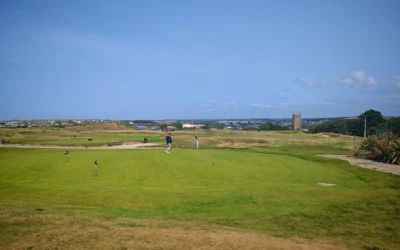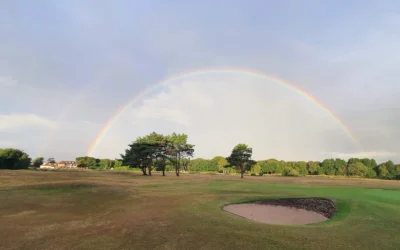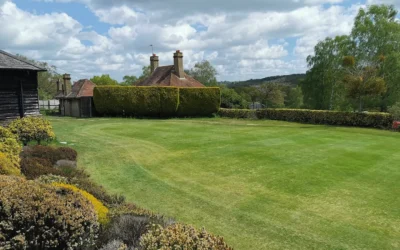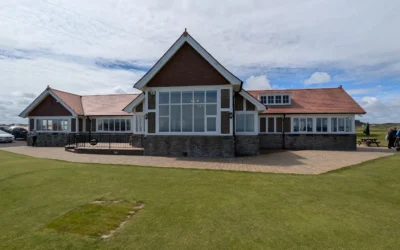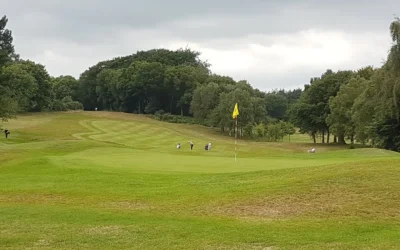Lindrick Golf Club
Lindrick Golf Club (Nottinghamshire, England)
Imagine standing on the 18th tee, the clubhouse looming ahead, as you prepare to play one of the world’s greatest par 3s, a hole etched in golfing lore during the 1957 Ryder Cup. Lindrick Golf Club, located on Lindrick Common near Worksop, Nottinghamshire, yet technically in South Yorkshire, is a pilgrimage for golfers. Its heathland and moorland landscape, framed by silver birch and gorse, blends natural beauty with strategic challenge. Since 1891, Lindrick has carved its place in history, most notably as the stage for Great Britain and Ireland’s triumphant Ryder Cup victory, making it a course where every swing connects you to golf’s storied past.
Key Details
- Location: Lindrick Common, Rotherham, South Yorkshire, S81 8BH, England
- Length: 6,725 yards (championship blue tees)
- Par: 71
- Designers: Old Tom Morris and Buff Wilson (original); Harry Colt, Willie Park Jr., Alister MacKenzie, Ken Moodie (redesigns)
- Established: 1891
- Notable Events: 1957 Ryder Cup, 1960 Curtis Cup, British Masters (1966, 1977), Women’s British Open (1977, 1988)
History and Significance
Founded in 1891 as the Sheffield and District Golf Club, Lindrick began as a nine-hole course on Lindrick Common, crafted by Old Tom Morris and Buff Wilson. Officially named Lindrick Golf Club in 1934, it expanded to 18 holes in 1894, with early enhancements by Tom Dunn. The course’s early years were shaped by its unique setting, straddling the borders of Yorkshire, Derbyshire, and Nottinghamshire, a quirk that made the 4th green a notable landmark.
Significant evolution came in the early 20th century, with architects like Harry Colt and Willie Park Jr. extending the layout to 6,010 yards by 1907. A major redesign in 1932 rerouted holes to avoid the A57 road, introducing tunnels for safe passage. In 2016, Ken Moodie added blue tees and revamped bunkering on 11 holes, enhancing strategic play. These changes ensured Lindrick remained a formidable test for professional events.
The 1957 Ryder Cup remains Lindrick’s crowning moment, where Great Britain and Ireland, led by Dai Rees, defeated the USA 7.5 to 4.5, ending a 24-year drought. This victory, celebrated on the 4th green, inspired a famous cartoon by Roy Ullyett, still displayed in the clubhouse. Lindrick also hosted the 1960 Curtis Cup, British Masters in 1966 and 1977, and Women’s British Open in 1977 and 1988, cementing its professional pedigree.
Today, Lindrick is ranked among England’s top courses, praised by golfers for its challenging layout and pristine condition. Its 18th hole, a favorite of Peter Alliss, underscores its global stature. Lindrick’s blend of history, design, and natural beauty makes it a cultural touchstone in golf.
Course Features
Lindrick’s layout is a captivating mix of heathland and moorland, stretching across 6,725 yards of common land. Generous fairways, lined with silver birch and gorse, invite bold drives but demand precision, as fast, subtly undulating greens and deep bunkers punish errant shots. The course’s parkland sections, framed by trees, contrast with open expanses, creating a dynamic golfing experience.
Unique features define Lindrick’s character. The 4th green, where Yorkshire, Derbyshire, and Nottinghamshire converge, is a geographical marvel, while two tunnels under the A57 allow seamless transitions between the course’s split layout (holes 1–11 and 18 on the south side, 12–17 on the north). Strategic bunkering, remodeled in 2016, and elevation changes challenge even seasoned players, with wind adding an unpredictable element. The course’s year-round playability, thanks to well-drained fairways, ensures no temporary greens, even in winter.
Scenically, Lindrick enchants with sweeping views of the surrounding countryside. The River Ryton behind the 4th green and the clubhouse’s imposing presence at the 18th enhance the experience. Golfers describe the course as a “gem,” with its pristine fairways and true greens offering a test that rewards strategy over brute force.
Signature Holes
4th Hole (Stubbings)
- Par 5, 550 yards (blue tees), Stroke Index 13
This picturesque par 5, designed by Tom Dunn, begins with a drive over gorse, with new bunkers accentuating its dogleg right. The blind approach to a sunken green, guarded by the River Ryton, demands precision. During the 1957 Ryder Cup, players trespassing on adjacent land sparked a dispute, immortalized in Roy Ullyett’s cartoon, a clubhouse treasure.
6th Hole (Moses)
- Par 3, 140 yards, Stroke Index 15
The shortest hole, Moses requires a carry over thick gorse and mounds to a green defended by steep bunkers. Its undulating surface, sloping right to left, makes par a feat. Golfers praise its deceptive challenge, where club selection is critical.
18th Hole
- Par 3, 210 yards, Stroke Index 10
A dramatic finale, this long par 3 faces the clubhouse, with remodeled bunkers (2016) amplifying its menace. Featured in lists of the world’s greatest holes and Peter Alliss’s favorite 18, it demands a bold shot to secure par, a fitting end to Lindrick’s test.
Why Visit
Lindrick beckons with its blend of challenge and history. Its heathland layout tests every facet of a golfer’s game, from tee shots navigating gorse to approaches on lightning-fast greens. The course’s fairness ensures players of all levels can enjoy the experience, though accuracy is paramount.
Walking Lindrick’s fairways evokes a connection to golf’s legends. The 1957 Ryder Cup victory, where Dai Rees’s team triumphed, resonates in every hole, particularly the 4th and 18th. Golfers call it a “must-play” for its history and warm hospitality.
With top-notch dining, a well-stocked pro shop, and coaching from Head Professional Andy Rossington, Lindrick offers a complete experience. “Exceptional, lovely course in great condition,” reflects its enduring appeal.
Facilities
The clubhouse, built between the World Wars, is an imposing structure with panoramic views of Lindrick Common. Its formal dining room serves daily lunches, while the Ryder Cup room offers lighter fare, all crafted by chef Matthew Webster. Refreshments, from coffee to sandwiches, cater to golfers pre- or post-round.
Practice facilities include areas for refining skills, complemented by a professional shop offering equipment and coaching. The club’s hospitality, praised for its friendliness, ensures a welcoming visit, though non-members may be restricted to certain areas due to traditional policies.
Contact Details and Directions
- Address: Lindrick Golf Club, Deep Carrs Lane, Lindrick Common, Rotherham, South Yorkshire, S81 8BH
- Phone: +44 (0)1909 475 282
- Email: Contact via website form
- Directions: 3 miles NW of Worksop, 12 miles E of Sheffield, 31 miles N of Nottingham via A57. From M1 J31, follow A57 toward Worksop; the club is signposted after 5.1 miles.
- Public Transport: Train to Worksop station (3 miles away), then taxi.
- Parking: Ample on-site parking.
- Map: View on Google Maps
Green Fees and Booking
Green fees vary by season, reflecting Lindrick’s premium status. Booking is straightforward via the club’s online visitor system at Lindrick Golf Club, with specific tee times allocated for non-members. A strict dress code emphasizes smart attire, and groups of 20+ may receive discounts.
|
Season |
Fee (Non-Resident) |
Notes |
|
June–September |
£135 |
Mon/Wed/Thu/Fri 09:45–11:00, 14:40+; Tue 14:40+ |
|
June–September |
£99 |
Select Thursdays, includes £20 food voucher |
|
April & October |
£90 |
|
|
May |
£110 |
|
|
November–March |
£75 |
Nearby Attractions
Beyond the fairways of Lindrick Golf Club, the Worksop area offers a tapestry of history, nature, and adventure. From sprawling estates to prehistoric caves, these attractions enrich any visit, ensuring golfers and companions alike find memorable experiences within a short drive of the course.
|
Attraction |
Appeal |
Distance |
|
Clumber Park |
National Trust gardens, parkland |
4 miles |
|
Creswell Crags |
Prehistoric caves, archaeology |
5 miles |
|
Tropical Butterfly House |
Wildlife, falconry displays |
6 miles |
|
Mr Straw’s House |
Historical home, National Trust |
3 miles |
|
Sherwood Forest |
Robin Hood legacy, Major Oak |
12 miles |
|
Bolsover Castle |
Fairy-tale castle, views |
9 miles |
Clumber Park: Just 4 miles from Lindrick, this 3,800-acre National Trust estate captivates with serene lakes, woodlands, and a historic walled garden boasting 135 rhubarb varieties. Perfect for families, it offers cycling trails, a discovery center, and seasonal events, blending nature and heritage for a relaxing day out.- Creswell Crags: Five miles away, this limestone gorge reveals Ice Age secrets through prehistoric cave art and artifacts dating back 10,000 years. Guided tours explore the caves, while a museum and trails provide context, making it an intriguing stop for history enthusiasts visiting the area.
- Tropical Butterfly House: Six miles from the course, this wildlife park delights with interactive animal encounters, from lemurs and meerkats to crocodiles. Daily falconry displays and a butterfly house create a vibrant family-friendly experience, ideal for a break from golf with engaging activities for all ages.
- Mr Straw’s House: A mere 3 miles away in Worksop, this National Trust property preserves a 1920s middle-class home, offering a nostalgic glimpse into early 20th-century life. Its untouched interiors, filled with original furnishings, provide a unique historical experience for those seeking cultural insights near Lindrick.
- Sherwood Forest: Twelve miles from Lindrick, this legendary woodland is synonymous with Robin Hood. The Major Oak, a centuries-old tree, anchors the visitor center, while walking trails and seasonal events immerse visitors in folklore and nature, making it a must for adventure seekers.
- Bolsover Castle: Nine miles away, this 17th-century fairy-tale castle perched on a hill offers stunning Derbyshire views. Explore its opulent interiors, ride the miniature railway, or wander the gardens. Its blend of history and scenic beauty makes it a captivating outing for Lindrick visitors.
Frequently Asked Questions (FAQs)
How do I book a tee time at Lindrick Golf Club?
Tee times are booked online via the visitor booking system on Lindrick Golf Club.
What are the green fees?
Fees range from £75 (November–March) to £135 (June–September), with special rates on select Thursdays.
Is there a dress code?
Yes, smart attire is mandatory; details are on Lindrick Golf Club.
Are caddies available?
Contact the club directly via Lindrick Golf Club to inquire about caddy availability.
What facilities are available at the clubhouse?
The clubhouse offers formal and informal dining, a pro shop, and practice areas.
How do I get to Lindrick Golf Club?
Located 3 miles NW of Worksop via A57; trains to Worksop station, then a short taxi ride.
Are there nearby golf courses?
Worksop Golf Club and Bondhay Golf Club are within 10 miles, offering additional golfing options.
What tournaments has Lindrick hosted?
Notable events include the 1957 Ryder Cup, 1960 Curtis Cup, and Women’s British Open.
Why is Lindrick famous?
Its 1957 Ryder Cup victory and top-100 ranking make it a golfing landmark.
Is accommodation available on-site?
No, but hotels like Clumber Park Hotel are nearby.
Is membership available?
Membership options exist; contact Lindrick Golf Club for details.
What is the best time to play?
April to October offers optimal conditions, though the course is playable year-round.
How is the weather typically?
UK weather varies; check forecasts before playing, as wind can affect play.
Can beginners play at Lindrick?
Yes, it’s suitable for all levels, though its challenges favor strategic play.
What makes Lindrick unique?
Its county-crossing layout, historical significance, and acclaimed 18th hole set it apart.
West Cornwall Golf Club
West Cornwall Golf Club (Lelant, St. Ives, Cornwall, England) Imagine teeing off with the Atlantic Ocean shimmering in the distance, the historic St Uny’s Church framing your shot, and the legacy of golfing greats like Jim Barnes inspiring your swing. West Cornwall...
Fairhaven Golf Club
Fairhaven Golf Club (Lytham, Lancashire, England) Tucked away in the heart of Lancashire’s famed “Golf Coast,” Fairhaven Golf Club is a hidden gem that blends over 125 years of golfing heritage with a captivating mix of links and parkland golf. Set within the tranquil...
Reigate Heath Golf Club
Reigate Heath Golf Club (Reigate, Surrey, England) Imagine teeing off on a crisp Surrey morning, surrounded by heather and gorse, with an 18th-century windmill standing sentinel nearby. Reigate Heath Golf Club, nestled in the heart of Surrey’s rolling countryside,...
Bamburgh Castle Golf Club
Bamburgh Castle Golf Club (Bamburgh, Northumberland, England) Perched on the dramatic clifftops of Northumberland’s coast, Bamburgh Castle Golf Club is a hidden gem that blends exhilarating golf with some of the most breathtaking scenery in England. As you stand on...
Sandiway Golf Club
Sandiway Golf Club (Cheshire, England) Nestled in the heart of Cheshire’s rolling countryside, Sandiway Golf Club stands as a testament to golfing excellence and tradition. Established in 1920, this prestigious course was crafted by legendary architects, including Ted...

